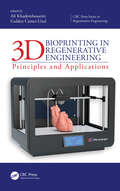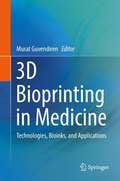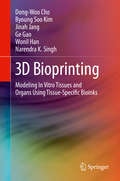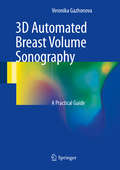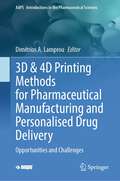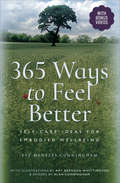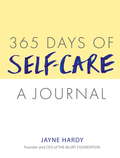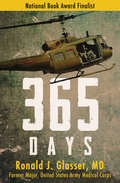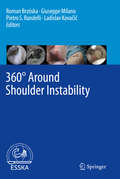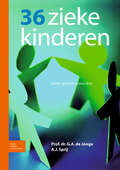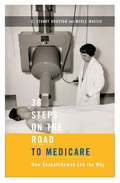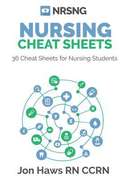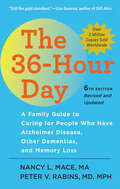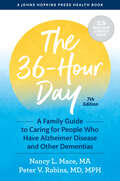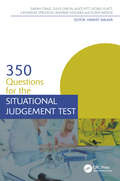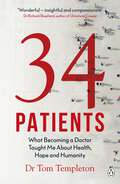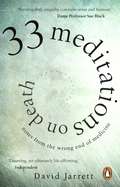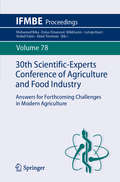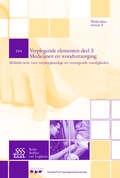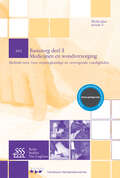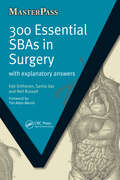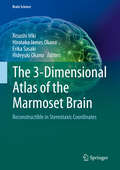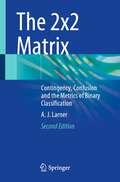- Table View
- List View
3D Bioprinting in Regenerative Engineering: Principles and Applications (CRC Press Series In Regenerative Engineering)
by Ali Khademhosseini Gulden Camci-UnalRegenerative engineering is the convergence of developmental biology, stem cell science and engineering, materials science, and clinical translation to provide tissue patches or constructs for diseased or damaged organs. Various methods have been introduced to create tissue constructs with clinically relevant dimensions. Among such methods, 3D bioprinting provides the versatility, speed and control over location and dimensions of the deposited structures. Three-dimensional bioprinting has leveraged the momentum in printing and tissue engineering technologies and has emerged as a versatile method of fabricating tissue blocks and patches. The flexibility of the system lies in the fact that numerous biomaterials encapsulated with living cells can be printed. This book contains an extensive collection of papers by world-renowned experts in 3D bioprinting. In addition to providing entry-level knowledge about bioprinting, the authors delve into the latest advances in this technology. Furthermore, details are included about the different technologies used in bioprinting. In addition to the equipment for bioprinting, the book also describes the different biomaterials and cells used in these approaches. This text: Presents the principles and applications of bioprinting Discusses bioinks for 3D printing Explores applications of extrusion bioprinting, including past, present, and future challenges Includes discussion on 4D Bioprinting in terms of mechanisms and applications
3D Bioprinting in Medicine: Technologies, Bioinks, and Applications
by Murat GuvendirenThis book provides current and emerging developments in bioprinting with respect to bioprinting technologies, bioinks, applications, and regulatory pathways. Topics covered include 3D bioprinting technologies, materials such as bioinks and bioink design, applications of bioprinting complex tissues, tissue and disease models, vasculature, and musculoskeletal tissue. The final chapter is devoted to clinical applications of bioprinting, including the safety, ethical, and regulatory aspects. This book serves as a go-to reference on bioprinting and is ideal for students, researchers and professionals, including those in academia, government, the medical industry, and healthcare.
3D Bioprinting: Modeling In Vitro Tissues and Organs Using Tissue-Specific Bioinks
by Dong-Woo Cho Byoung Soo Kim Jinah Jang Ge Gao Wonil Han Narendra K. SinghThis text advances fundamental knowledge in modeling in vitro tissues/organs as an alternative to 2D cell culture and animal testing. Prior to engineering in vitro tissues/organs,the descriptions of prerequisites (from pre-processing to post-processing) in modeling in vitro tissues/organs are discussed. The most prevalent technologies that have been widely used for establishing the in vitro tissue/organ models are also described, including transwell, cell spheroids/sheets, organoids, and microfluidic-based chips. In particular, the authors focus on 3D bioprinting in vitro tissue/organ models using tissue-specific bioinks. Several representative bioprinting methods and conventional bioinks are introduced. As a bioink source, decellularized extracellular matrix (dECM) are importantly covered, including decellularization methods, evaluation methods for demonstrating successful decellularization, and material safety. Taken together, the authors delineate various application examples of 3D bioprinted in vitro tissue/organ models especially using dECM bioinks.
3D Automated Breast Volume Sonography: A Practical Guide
by Veronika GazhonovaThisbook introduces an exciting new method for breast ultrasound diagnostics - automatedwhole-breast volume scanning (3D ABVS). Scanning technique is described indetail, with guidance on scanning positions and protocols. Imaging findings arethen illustrated and discussed for normal breast variants, the different formsof breast cancer, fibroadenomas, cystic disease, benign and malignant malebreast disorders, mastitis, breast implants, and postoperative breast scars. Inorder to aid appreciation of the benefits of 3D ABVS, comparisons with findingson X-ray mammography and conventional 2D hand-held US are presented. Readerswill be especially impressed by the convincing demonstration of the advantagesof the new method for diagnosis of breast cancer in women with dense glandulartissue. In enabling readers to learn how to perform and interpret 3D ABVS, thisbook will be of great value for all who are embarking on its use. It will alsoserve as a welcome reference for radiologists, oncologists, and ultrasonographerswho already have some familiarity with the technique.
3D & 4D Printing Methods for Pharmaceutical Manufacturing and Personalised Drug Delivery: Opportunities and Challenges (AAPS Introductions in the Pharmaceutical Sciences #11)
by Dimitrios A. LamprouNew materials and manufacturing techniques are emerging with potential to address the challenges associated with the manufacture of pharmaceutical systems that will teach new tricks to old drugs. 3D printing (3DP) is a technique that can used for the manufacturing of dosage forms, and especially targeting paediatric and geriatric formulations, as permits the fabrication of high degrees of complexity with great reproducibility, in a fast and cost-effective fashion, and offers a new paradigm for the direct manufacture of personalised dosage forms. The book is covering the basics behind each additive manufacturing (AM) method, current applications in pharmaceutics for each 3DP method, and case studies (examples) from a teaching perspective, targeting undergraduate (UG) and postgraduate (PG) students. A unique to this book is the integration of studies based upon the use of different AM technologies, which designed to reinforce importance printing parameters and material considerations. The book includes case studies or multiple-choice questions (MCQs), which allow application of the content in a flipped-classroom.
365 Ways to Feel Better: Self-Care Ideas for Embodied Wellbeing
by Eve Menezes Cunningham Amy Brennan-Whittington Alan Cunningham'This book will transform your life. Radical self-care in easy baby steps, what's not to love?' ~ Suzy Greaves, Psychologies EditorThis is a fabulous book. So very well thought out, planned and executed and with a wonderful accessible yet respectful style. Buy yourself this book and sit down and devour it in the way that suits you best. Then buy a copy for someone else ~ Debra Jinks, co-author of Personal Consultancy: A Model for Integrating Counselling and Coaching_365 Ways to Feel Better_ offers simple but effective tools for each day of the year. Eve Menezes Cunningham integrates her background in coaching, counseling, yoga and other therapies to share practical tools for mind, body, heart and soul. With an overall aim of supporting people in feeling better in all areas of their lives, Eve encourages the reader to learn to trust in their own capacity to heal and feel better, with a playful approach to their self-care.From goal setting to inner child work, chakras to beneficial yoga poses, breath practices to psychological tools, meditation techniques to aura cleansing, this book offers a taste of a comprehensive range of mind-body tools to help you boost your health and well-being yourself.365 Ways to Feel Better is for anyone who wants to boost their well-being in a holistic, side-effect-free way. Self-help fans will enjoy it but also, complementary therapists, energy workers, yoga instructors, therapists and yogis, counsellors, coaches and more.
365 Days of Self-Care: A Journal
by Jayne HardyIt's one thing to understand how important self-care is, but how many of us actually manage to make the time do it?In 365 Days of Self-Care, CEO and founder of The Blurt Foundation, Jayne Hardy encourages you to take some time each and every day to be mindful, to check-in and prioritise the things that are truly important to you. This ebook edition contains: 365 daily prompts and trackers to note your moods, sleep and more; thoughtful mini-essays to prompt some deeper work; and check-in pages to help you see your progress - everything you need to get started on your self-care journey. Examples of daily prompts include:· Day 1: Boost· Day 52: Appreciate· Day 142: Rebel· Day 209: Thankful· Day 327: CourageWith the flexibility of choosing to start the journal anytime; on any day, in any year, this is the essential companion for bringing more self-care into your life.
365 Days of Self-Care: A Journal
by Jayne HardyIt's one thing to understand how important self-care is, but how many of us actually manage to make the time do it?In 365 Days of Self-Care, CEO and founder of The Blurt Foundation, Jayne Hardy encourages you to take some time each and every day to be mindful, to check-in and prioritise the things that are truly important to you. This ebook edition contains: 365 daily prompts and trackers to note your moods, sleep and more; thoughtful mini-essays to prompt some deeper work; and check-in pages to help you see your progress - everything you need to get started on your self-care journey. Examples of daily prompts include:· Day 1: Boost· Day 52: Appreciate· Day 142: Rebel· Day 209: Thankful· Day 327: CourageWith the flexibility of choosing to start the journal anytime; on any day, in any year, this is the essential companion for bringing more self-care into your life.
365 Days: 50th Anniversary Edition
by Ronald J. GlasserNational Book Award Finalist: The Vietnam War as seen through the eyes of an army doctor—&“a book of great emotional impact&” (The New York Times). In 1968, as a serviceman in the Vietnam War, Dr. Ronald Glasser was sent to Japan to work at the US Army hospital at Camp Zama. It was the only general army hospital in Japan, and though Glasser was initially charged with tending to the children of officers and government officials, he was soon caught up in the waves of casualties that poured in from every Vietnam front. Thousands of soldiers arrived each month, demanding the help of every physician within reach. In 365 Days, Glasser reveals a candid and shocking account of that harrowing experience. He gives voice to seventeen of his patients, wounded men counting down the days until they return home. Their stories bring to life a world of incredible bravery and suffering, one where &“the young are suddenly left alone to take care of the young.&” An instant classic of war literature, 365 Days is a remarkable, ground-level account of Vietnam&’s human toll.
360° Around Shoulder Instability
by Roman Brzóska Giuseppe Milano Pietro S. Randelli Ladislav KovačičThis book presents the current status of shoulder instability treatment with the aim of equipping readers with a comprehensive understanding of the latest concepts of shoulder instability, diagnosis and the decision-making process, conservative treatment, state of the art surgical techniques, and management of treatment failures. Written by leading European and overseas specialists, the book merges the authors’ clinical experience with expert opinions and up-to-date research data to offer shoulder surgeons, physiotherapists, other shoulder practitioners, and residents strong support in everyday practice. The coverage encompasses such pathologies as ALPSA, SLAP, HAGL, and Bankart lesions, and readers will find clear descriptions of soft tissue management, arthroscopic and open stabilization techniques, and recently published bone transfer techniques. Not only is the book copiously illustrated, but it also includes case examples, further illustrations, and links to high-resolution videos of the newest shoulder stabilization techniques performed by globally renowned experts. 360° Around Shoulder Instability is published in cooperation with ESSKA-ESA and is based on the 2nd biennial ESSKA-ESA meeting of the same name.
36 zieke kinderen
by Guus Jonge Arwen SprijErvaring opdoen met echte patiënten is een essentieel onderdeel van iedere geneeskundige opleiding. In het contact met patiënten leert de co-assistent de theorie toe te passen en de problemen van de patiënt te herkennen en te formuleren. Maar er is altijd een tekort aan nieuwe 'echte' patiënten in de opleiding. 36 zieke kinderen is een papieren aanvulling op het aantal beschikbare echte patiënten. In dit boek leeft u zich in als arts betrokken bij kinderen. In dit boekje kunt u vragen bij uiteenlopende klachten, zoals acute diarree, congenitale heupdysplasie en schoolproblematiek beantwoorden, door de antwoorden te noteren zoals u dat zou doen in het patiëntendossier: kort en bondig, puntsgewijs en overzichtelijk. Na iedere patient kunt u uw antwoorden vergelijken met de suggesties van de auteurs. Uiteraard zijn er voor veel problemen geen standaardantwoorden. Soms zal zelfs doorverwijzing de beste optie zijn. Voor verdere studie en verdieping vindt u na elke bespreking een suggestie voor nadere literatuur. Deze derde druk van 36 zieke kinderen is bedoeld voor co-assistenten en basisartsen.
36 Steps on the Road to Medicare: How Saskatchewan Led the Way
by C. Stuart Houston Merle MassieThe co-operative spirit of citizens in twentieth-century Saskatchewan nurtured innovation in health care and health policy. 36 Steps on the Road to Medicare showcases the decisions that led to the province's medicare system - the forerunner of Canadian health care. Stuart Houston and Merle Massie document the range of Saskatchewan leadership on Canadian, North American, and world stages: municipal doctors and municipal hospitals, the first Red Cross Outpost Hospital in the British Empire, tuberculosis diagnosis and treatment, a successful pilot comprehensive regional health care plan, government-sponsored cancer clinics, innovative LSD and patient-oriented treatment for psychoses, the first full-time cancer physicist in Canada, and the world's first concerted clinical use of the betatron and Cobalt-60 in cancer treatment. They show how North America's first social-democratic government, the Co-operative Commonwealth Federation - elected in 1944 and led by the incomparable Tommy Douglas - created the blueprint for comprehensive health care and how sequential steps on the road to medicare were implemented quickly and within budget. When federal support for national hospitalization became available, Saskatchewan could afford to initiate medicare in 1962. Other Canadian provinces soon followed Saskatchewan's lead. Updated to engage with current debates, 36 Steps on the Road to Medicare navigates the history of medicare and demonstrates the spirit of innovation that Canada will need to save it.
36 Steps on the Road to Medicare
by Merle Massie C. Stuart HoustonThe co-operative spirit of citizens in twentieth-century Saskatchewan nurtured innovation in health care and health policy. 36 Steps on the Road to Medicare showcases the decisions that led to the province's medicare system - the forerunner of Canadian health care. Stuart Houston and Merle Massie document the range of Saskatchewan leadership on Canadian, North American, and world stages: municipal doctors and municipal hospitals, the first Red Cross Outpost Hospital in the British Empire, tuberculosis diagnosis and treatment, a successful pilot comprehensive regional health care plan, government-sponsored cancer clinics, innovative LSD and patient-oriented treatment for psychoses, the first full-time cancer physicist in Canada, and the world's first concerted clinical use of the betatron and Cobalt-60 in cancer treatment. They show how North America's first social-democratic government, the Co-operative Commonwealth Federation - elected in 1944 and led by the incomparable Tommy Douglas - created the blueprint for comprehensive health care and how sequential steps on the road to medicare were implemented quickly and within budget. When federal support for national hospitalization became available, Saskatchewan could afford to initiate medicare in 1962. Other Canadian provinces soon followed Saskatchewan's lead. Updated to engage with current debates, 36 Steps on the Road to Medicare navigates the history of medicare and demonstrates the spirit of innovation that Canada will need to save it.
36 Nursing Cheat Sheets for Nursing Students
by Jon Haws<p>Ready to take your studies to the next level? This ebook contains the most needed, most referenced, and sometimes most confusing information in an easy to read, understand, and remember way.36 nursing reference pages in full color ranging in topics from respiratory to medication you will love having this handy book on your phone while in clinical or class. <p>Stop wasting time. Look we've all been there. . . nursing school is hard. You never know what is MOST important and what you should be focusing on. Not any more. With this easy to read and use book you have exactly what you need right at your finger tips.With tables, pictures, graphs and more . . . you are ready to soar! Perfect for the new nurse or nursing student looking to save time and energy in their studies.</p>
The 36-Hour Day: A Family Guide to Caring for People Who Have Alzheimer Disease, Other Dementias, and Memory Loss (A Johns Hopkins Press Health Book)
by Nancy L. Mace Peter V. RabinsAfter 35 years, still the indispensable guide for countless families and professionals caring for someone with dementia.Through five editions, The 36-Hour Day has been an essential resource for families who love and care for people with Alzheimer disease. Whether a person has Alzheimer disease or another form of dementia, he or she will face a host of problems. The 36-Hour Day will help family members and caregivers address these challenges and simultaneously cope with their own emotions and needs.Featuring useful takeaway messages and informed by recent research into the causes of and the search for therapies to prevent or cure dementia, this edition includes new information on• devices to make life simpler and safer for people who have dementia• strategies for delaying behavioral and neuropsychiatric symptoms• changes in Medicare and other health care insurance laws• palliative care, hospice care, durable power of attorney, and guardianship• dementia due to traumatic brain injury• choosing a residential care facility• support groups for caregivers, friends, and family membersThe central idea underlying the book—that much can be done to improve the lives of people with dementia and of those caring for them—remains the same. The 36-Hour Day is the definitive dementia care guide.
The 36-Hour Day: A Family Guide to Caring for People Who Have Alzheimer Disease and Other Dementias (A Johns Hopkins Press Health Book)
by Nancy L. Mace Peter V. RabinsWith over 3.5 million copies sold, the bestselling guide to understanding and caring for people with dementia is now completely revised and updated!For 40 years, The 36-Hour Day has been the leading work in the field for caregivers of those with dementia. Written by experts with decades of experience caring for individuals with memory loss, Alzheimer's, and other dementias, the book is widely known for its authoritativeness and compassionate approach to care. Featuring everything from the causes of dementia to managing its early stages to advice on caring for those in the later stages of the disease, it is widely considered to be the most detailed and trusted book available. Highlighting useful takeaway messages and informed by recent research into the causes of dementia, this new edition has been completely updated. It features • brand-new content on everything from home care aides to useful apps to promising preventative techniques and therapies• practical advice for avoiding caregiver burnout—plus tips for when and how to get additional help• a completely new two-column design that allows readers to quickly access what they needThe central idea underlying this indispensable book—that much can be done to improve the lives of people with dementia and of those caring for them—remains the same. The 36-Hour Day is the definitive dementia care guide.
350 Questions for the Situational Judgement Test (Medical Finals Revision Series)
by Sarah Craig Giles Dixon Alice Pitt Isobel Platt Catherine Sproson Andrew Viggars Eileen WedgeThis book presents over 350 ranking and multiple-choice questions, arranged by subject groups aligned with the domains of the SJT examination, and designed specifically to explore the readiness of candidates to face the scenarios that they will encounter as a junior doctor. A clear discussion of how the correct answer was reached and other options ruled out for every question is given at the end of each chapter, making this book an excellent learning aid through all stages of undergraduate studies, and particularly during revision for the SJT examination.
34 Patients: The profound and uplifting memoir about the patients who changed one doctor’s life
by Tom TempletonDiscover the profound and moving portrait of one doctor's life and work in the NHS'Wonderful - insightful and compassionate' Dr Richard Shepherd, bestselling author of Unnatural Causes________They can't teach you how to be a doctor at medical school . . .As a junior doctor, Dr Tom Templeton learnt how to do his job from books, professors and other doctors and nurses. But the most important lessons - tolerance, kindness, resilience and bravery - he learnt from his patients.Here, he shares the stories of just 34, and how they changed his life while he was helping theirs.From a stillbirth to the old woman who lived a century, from the inhabitants of stately homes to the homeless, these stories whether heartwarming or heartbreaking, funny or tragic, are always inspiring and illuminating.We are all patients, but discover for the first time how the doctors see us . . .________'An admirably told story' Spectator'Informative and personal, humbling and healing' Observer
33 Meditations on Death: Notes from the Wrong End of Medicine
by David JarrettAS FEATURED ON BBC RADIO 4 'Start the Week' : 'very moving - brilliant and profound'"Brilliant - a grimly humorous yet humane account of the realities of growing old in the modern age." - Henry Marsh"A remarkably likeable guide to a grisly subject ... daunting, yet ultimately life-affirming" - Independent What is a good death? How would you choose to live your last few months? How do we best care for the rising tide of very elderly? This unusual and important book is a series of reflections on death in all its forms: the science of it, the medicine, the tragedy and the comedy. Dr David Jarrett draws on family stories and case histories from his thirty years of treating the old, demented and frail to try to find his own understanding of the end. Profound, provocative, strangely funny and astonishingly compelling, it is an impassioned plea that we start talking frankly and openly about death. He writes about all the conversations that we, our parents, our children, the medical community, our government and society as a whole should be having. And it is a call to arms for us to make radical changes to our perspective on 'the seventh age of man'.-More praise for 33 Meditations on Death:"This book will stay with you." - Derren Brown"Bursting with empathy, common sense and humour." - Professor Dame Sue Black
30th Scientific-Experts Conference of Agriculture and Food Industry: Answers for Forthcoming Challenges in Modern Agriculture (IFMBE Proceedings #78)
by Enisa Omanović-Mikličanin Muhamed Brka Lutvija Karić Vedad Falan Almir ToromanThis book gathers the proceedings of the 30th Scientific-Experts Conference of Agriculture and Food Industry, held on September 26-27, 2019, in Sarajevo, Bosnia and Herzegovina. It reports on the application of innovative technologies in food sciences and agriculture, and covers research in plant and animal production, agricultural economics and food production. Further, the book discusses key social and environmental issues, and proposes answers to current challenges. The conference was jointly organized by the Faculty of Agriculture and Food Sciences of the University of Sarajevo, Bosnia and Herzegovina, the Faculty of Agriculture of Ege University, Turkey, the Bosnia and Herzegovina Medical and Biological Engineering Society, and the Faculty of Agriculture of the University of Belgrade, Serbia. The proceedings offer a timely snapshot of cutting-edge, multidisciplinary research and developments in modern agriculture. As such, they address the needs of researchers and professionals, agricultural companies, food producers, and regulatory and food safety agencies.
304 Verplegende elementen: Werkcahier Kwalificatieniveau 3 (Skillslab-serie)
by Judith Alkema Marion VroonWerkcahier inclusief de cd–rom's Medicijnen en WondverzorgingDit cahier vormt een onderdeel van de cahiers voor de deelkwalificatie 304: verplegende elementen.
302 Basiszorg deel 3 Medicijnen en wondverzorging: Basiszorg: deel 3 (niveau 3) (Skillslab-serie)
by Judith AlkemaDit cahier vormt een onderdeel van de cahiers rondom de basiszorg voor verzorgenden. In dit werkcahier zijn de volgende onderwerpen opgenomen: het toedienen van medicijnen en wondverzorging.
300 Essential SBAs in Surgery: With Explanatory Answers (MasterPass)
by Kaji Sritharan Samia Ijaz Neil RusselMedical education and the tools used for assessment are continually evolving. Single Best Answer (SBA) questions are a relatively new method of assessment commonly encountered in final surgical exams. The key to success in any SBA-style examination is practice, practice and more practice. With nearly 300 structured questions, this book comprehensively covers the surgical curriculum. Each specialty-specific chapter contains a combination of clinical vignettes and knowledge-based questions of varying degrees of difficulty, both challenging the more able candidates as well as giving a realistic appreciation of the standard required to pass. Each question gives a detailed explanation of the correct answer to aid reflection and reinforce understanding. This book is the ideal revision aid for all undergraduate medical students preparing for their final examination in surgery. In addition, doctors studying for the Membership of the Royal College of Surgeons (MRCS) and the Professional and Linguistic Assessment Board (PLAB) examinations will also find this book extremely useful.
The 3-Dimensional Atlas of the Marmoset Brain: Reconstructible In Stereotaxic Coordinates (Brain Science)
by Atsushi Iriki Hirotaka James Okano Erika Sasaki Hideyuki OkanoThis book provides accurate, comprehensive, and convenient reference for usages of the “freely rotatable three dimensional combined Nissl-stained and MRI digital data of the marmoset brain”. The key features of the original 3D digital data and of this atlas are: 1. The original digital datasets are freely rotatable in three dimensions, thus expected to be useful for any disciplines and anatomical interest, using any coordinate system, 2. Combined Nissl stained and MRI images are obtained from the same marmoset, to allow cross-modality matched references for multiple usages, 3. 86 Horizontal Series of Images with Neurosurgical Plane (based on the actual data), with more accuracy and resolution (Chapter 2) than the web-based digital images, 4. 32 Coronal Series of Images with Neurosurgical Plane (reproduced from the brain model) (Chapter 3), 5. 10 Parasagittal Series of Images with Neurosurgical Plane (reproduced from the brain model) (Chapter 4), 6. 3 Omnidirectionally Sliceable Planes (reproduced from the brain model) (Chapter 5), 7. In order to provide higher resolution structures to match systematic accuracy for supplementation of the digital data on the website, additional information are included. They are: 1) Nomenclature, 2) List of Brain Structures in Hierarchical Order, 3) Index of Abbreviations, together with 143 useful Bibliographic References list as of 2016, 8. Horsley-Clarke’s stereotaxic coordinates were adopted in the present atlas.
The 2x2 Matrix: Contingency, Confusion and the Metrics of Binary Classification
by A. J. LarnerThis book describes, extends, and illustrates the metrics of binary classification through worked examples.Worked examples based on pragmatic test accuracy study data are used in chapters to illustrate relevance to day-to-day clinical practice. Readers will gain an understanding of sensitivity and specificity and predictive values along with many other parameters.The contents are highly structured, and the use of worked examples facilitates understanding and interpretation.This book is a resource for clinicians in any discipline who are involved in the performance or assessment of test accuracy studies and professionals in the disciplines of machine learning or informatics wishing to gain insight into clinical applications of 2x2 tables.
